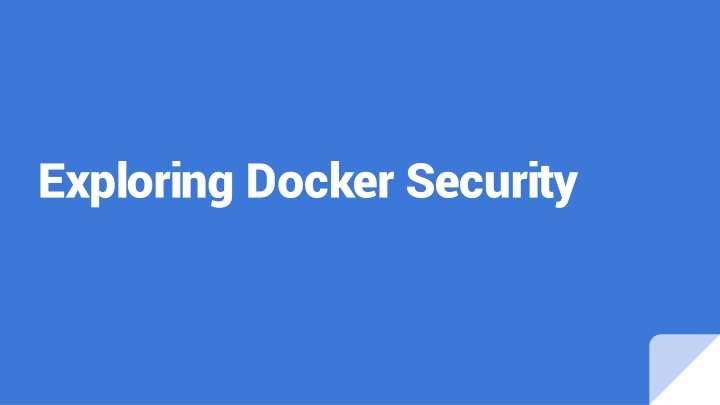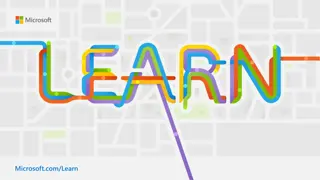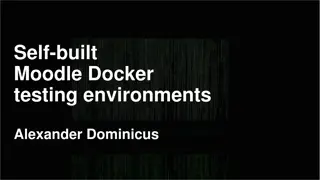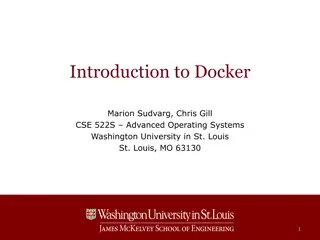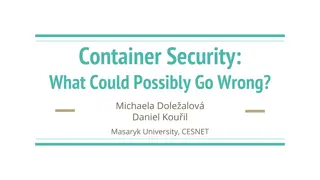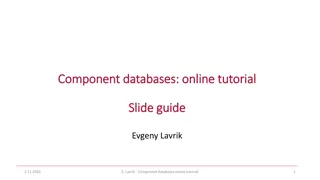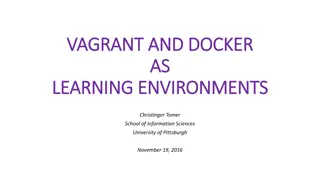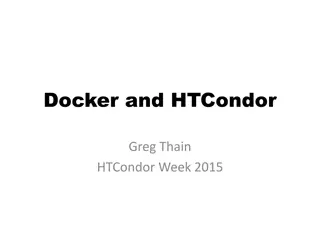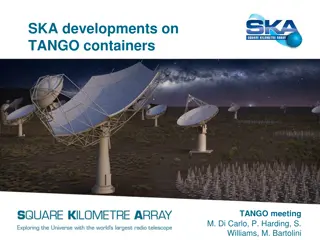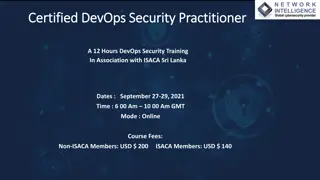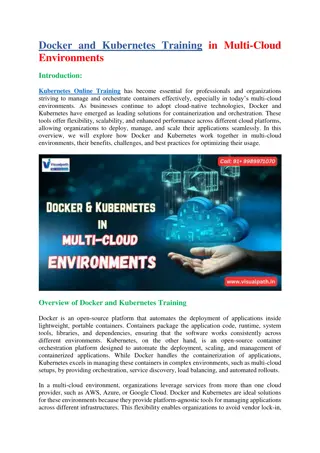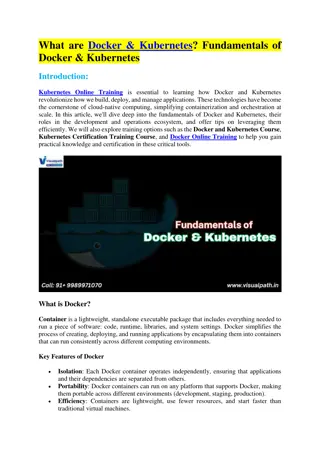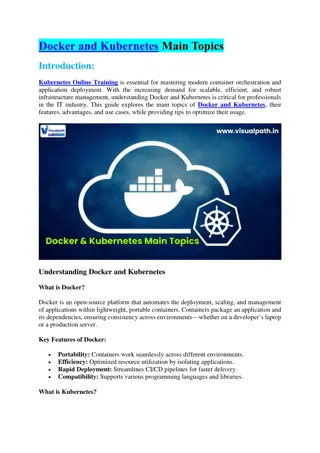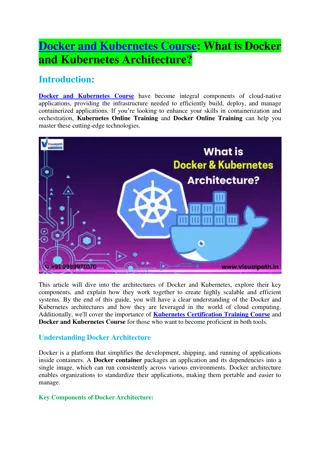Exploring Docker Security
In-depth review of Docker security, hardware virtualization, and VMs. Explore pros and cons of hardware virtualization, Docker architecture, and the Container approach. Learn about Docker's history, ease of application packaging, and its role in the DevOps movement.
Download Presentation

Please find below an Image/Link to download the presentation.
The content on the website is provided AS IS for your information and personal use only. It may not be sold, licensed, or shared on other websites without obtaining consent from the author.If you encounter any issues during the download, it is possible that the publisher has removed the file from their server.
You are allowed to download the files provided on this website for personal or commercial use, subject to the condition that they are used lawfully. All files are the property of their respective owners.
The content on the website is provided AS IS for your information and personal use only. It may not be sold, licensed, or shared on other websites without obtaining consent from the author.
E N D
Presentation Transcript
$ whoami Patrick Kleindienst Computer Science & Media (CS3) student trainee at Bertsch Innovation GmbH (since 2014) interested in Linux, software development, infrastructure etc. 2
Outline Review: Hardware virtualization and VMs Docker at a glance Container internals (using the example of Docker) Container security: How secure is Docker? Conclusion and further thoughts Discussion 3
Review:Hardware virtualization and VMs Virtual Machine basics Pros and Cons 4
Review: Virtual Machine basics VM = replication of a computer system runs a whole operating system with its own OS kernel hypervisor creates a virtual environment for each VM (RAM, CPU, Storage, ..) hypervisor as an abstraction layer between host and guest(s) each host may run multiple guest VMs 5
Hardware Virtualization: Pros and Cons single kernel per VM offers high degree of isolation full kernel = almost certainly many bugs hypervisor may also ship with bugs hypervisor reduces attack surface not as efficient as an ordinary host VM escape is considered very difficult running on virtual hardware is slower than physical hardware improvement of hardware resources utilization highly elastic infrastructure based on VMs is not so easy guest OS may be different from host OS 6
About Docker Docker at a glance The Container approach Docker architecture Demo 7
About Docker started as dotCloud (shipping Software with LXC) release of Docker as Open Source Project (2013) slogan: Build, Ship, Run ease of packaging and deploying applications focused on usability trigger for DevOps movement 8
The Container approach no more hypervisor, no more VMs lightweight Docker Engine running on top of host OS Docker engine runs apps along with their dependencies as isolated processes sharing the host kernel (Containers) Starting/Stopping a container takes seconds instead of minutes (or even hours) 9 Container comes with minimal
Docker architecture (1) Docker Image: read-only template containing a minimal OS (e.g. Ubuntu, Debian, CentOS, ..) may also contain additional layers (JRE, Python, Apache, VIM, ..) published and shared by means of Dockerfiles Docker Container: additional read-write layer on top of an image 10 does not manipulate the underlying image
Docker architecture (2) Docker Client: for interaction with Docker Daemon shares a UNIX socket with the daemon Docker Daemon: connects to the same UNIX socket as the client responsible for starting, stopping and monitoring containers 11 Docker Engine:
What weve learned so far: In contrast to VMs, containers running on the same host share the underlying kernel Therefore, they re lightweight and save lots of resources As for starting/stopping/setup, they re also much faster than traditional VMs Docker distinguishes between Images and Containers Docker Images ship with at least a single minimal OS layer 12
What we DONT know so far: Thinking about the underlying technology: What exactly are file system layers and Copy-on-Write? How to provide isolation between multiple containers running on same host? Did Docker really invent all this stuff?? Thinking about security: Eeehm, how secure is running a container in the first place? 13 And what about Docker?
Union file systems Container internals (using the example of Docker) Namespaces Control groups Putting it all together 14
Union file systems (AUFS) unification filesystem:stack of multiple directories on an Linux host which provides a single unified view (like stacked sheets on a overhead projector) involved directories need a shared mount point (union mount) shared mount point provides a single view on the mounted directories a directory participating in a union mount is called a branch result: each layer simply stores what has changed compared to the layers beneath it 15
Namespaces isolation mechanism of the Linux kernel provide processes with a different views on global resources examples: PIDs, network interfaces, mount points processes can work on that views without affecting the global configuration Linux makes use of certain system calls for namespace creation 18
Mount Namespaces Linux OS maintains data structure containing all existing mount points (which fs is mounted on which path?) Kernel allows for cloning this data structure and pass is to a process or group of processes Process(es) can change their mount points without side-effects e.g. allows for changing the root fs (similar to chroot) 19
PID Namespaces in a single process tree, a privileged process may inspect or kill other processes Linux kernel allows for nested PID namespaces Processes inside a PID namespace are not aware of what s going on outside However, processes in the outer PID namespace consider them as regular members of the outer process tree 20
Network Namespaces allows a process/group of processes to see a different set of network interfaces each container gets assigned a virtual network interface each virtual network interface is connected to the Docker daemon s docker0 interface docker0 routes traffic between containers and the host (depending on settings) default network interface is bridge 21
Control groups (cgroups) mechnism for limiting certain resources a process/group of processes can call for e.g. CPU, Memory, device access, network (QoS), .. a cgroup as a whole can be frozen and later unfrozen freeze mechanism allows to easily stop associated idling processes and to wake them up if necessary might prevent a container from running amok (e.g. binds all resources or congesting a disk) 22
What weve learned: union file systems enable re-use of single image layers a container makes use of CoW in order to work on read-only images multiple namespaces provided by host kernel allow for isolated execution of container processes cgroups as a means for limiting access and resource consumption 23
As for security, questions remain: The container default user is root. What happens if anyone succeeds breaking out of a container? Is container breakout even possible? What about container threats in general? What about client-side authentication/authorization in Docker? Is there any option to verify the publisher of Docker images in order to avoid tampering and replay attacks? 24
uid 0 -one account to rule them all Demo: Container breakout Container security: How secure is Docker? User namespaces, capabilities and MAC Common container threats Docker CLI AuthN/AuthZ Docker Content Trust 25
uid 0 -one account to rule them all to get that clear: considering the mechanisms introduced so far, there s actually no difference between host root and container root!! this can even be expanded: Any user allowed to access the Docker daemon is effectively root on the host!! This is also true for otherwise unprivileged users belonging to the docker group Sounds incredible? Watch and be astonished ;) 26
User namespaces to the rescue problem: container root is root on host is case of breakout solution: root remapping (introduced with Docker 1.10) maps uid 0 inside container to arbitrary uid outside the container caution: user namespaces are disabled by default! confinement: there s only one single user namespace per Docker daemon, not per container 27 Demo: Hey, it works!
Taming root with Capabilities? another problem: setuid-root binaries (e.g. /bin/ping) these binaries are also executed with the rights of their owner (guess which user owns ping) heavily increases the risk of privilege escalation in case of flaws capabilities idea: grant fine-granular access only to what s absolutely needed (network sockets in case of ping) allows for unprivileged containers (missing in Docker) 28
One last try: Mandatory Access Control (MAC) Linux standard: Discretionary Access Control (DAC) another approach: Mandatory Access Control (MAC) grants access only by the actor s identity (access rights per user) access is granted by a policy or rather fine- granular rules every resource (file, directory, ..) has a owning user/group Linux implementations: SELinux, AppArmor (rules per file/directory) Linux manages acess rights for owner, group and world (rwx) there re ready-to-use templates offered by Docker for both writing own policy is tricky and error-prone 29
Container threats: Escaping What s happening? compromising of the host worst case: attacker can do anything on the host system Why does it happen? lack of user namespaces insecure defaults/weak configuration (user namespaces disabled) 30 user namespaces disabled
Container threats: Cross-container attacks What s happening? compromising of sensitive containers (e.g.database container) ARP spoofing and steal of credentials DoS attack (e.g. XML bombs) Why does it happen? weak network defaults (default bridge configuration in Docker) 31 poor/missing resource limitation defaults
Container threats: Inner-container attacks What s happening? attacker gains unauthorized access to a single container root cause of previous container threats Why does it happen? typically due to non-container related flaws (e.g. webapp vulnerabilities) out of date software 32 exposing a container to insecure/untrusted networks
Docker CLI AuthN/AuthZ [This page is intentionally left blank] Ok, there s still TLS .. 33
Docker Registry: Challenges Docker Registry = kind of git repositoy for Docker Images (public/private) Handy for collaboration (e.g. in organization context) challenge 1: Make sure that docker pull actually gives us exactly the content that we want (identity/integrity) challenge 2: Make sure that we always get the latest version of a requested software (freshness) 34
Docker Registry: Attacks (1) Scenario 1: Attacker hacks into registry server and tampers a single layer of an up-to-date image (image forgery) 35
Docker Registry: Attacks (2) Scenario 2: Attacker hacks into registry server and provides content which is actually out of date (replay attack) 36
Docker Content Trust: Notary Implementation of The Update Framework (TUF),which has its origins in the TOR project (Apache license) focus: publisher identity & freshness guarantees relies on several keys which are stored at physically different places oncept of online and offline keys (compared to simple GPG) offline (root) key remains on a USB stick, smart card, .. 37 root key signs other keys (timestamp key, tagging key)
Docker Content Trust: Registry V2 Content Addressable System (key-value store) pull by hash/pull by digest: key = hash(object) self-verifying system (integrity) docker pull is a secure operation, as long as we get the correct hash quiz game: How can we ensure to always get the correct hash? 39
Conclusion and further thoughts Container systems become more and more security-aware However, container security is still work in progress Namespaces and Capabilities are relatively new kernel features (buggy?) root seems to be a never-ending problem Docker provides useful defaults, but lacks support for fine-granular AuthN/AuthZ 40 Interesting question: Does any software developer have to move towards a
Thanks for your attention! Any questions? Contact: pk070@hdm-stuttgart.de Twitter: @Apophis1990 41
Sources (1) Internet: Docker Inc. (2016): Docker Docs [https://docs.docker.com/] Docker Inc. (2016): What is Docker? [https://www.docker.com/what-docker] Ridwan, Mahmud (2016): Separation Anxiety: A Tutorial for Isolating Your System with Linux Namespaces [https://www.toptal.com/linux/separation-anxiety-isolating-your-system-with-linux-namespaces] Wikipedia (2016): Descretionary Access Control [https://de.wikipedia.org/wiki/Discretionary_Access_Control] Wikipedia (2016): Virtuelle Maschine [https://de.wikipedia.org/wiki/Virtuelle_Maschine] Literature: 42 Grattafiori, Aaron (2016): (NCC Group Whitepaper)
Sources (2) Graphics: https://assets.toptal.io/uploads/blog/image/674/toptal-blog-image-1416487554032.png https://assets.toptal.io/uploads/blog/image/675/toptal-blog-image-1416487605202.png https://c2.staticflickr.com/8/7336/14098888813_1047e39f08.jpg https://blog.docker.com/wp-content/uploads/2015/08/dct1.png https://blog.docker.com/wp-content/uploads/2015/08/dct2.png https://blog.docker.com/wp-content/uploads/2015/08/dct3.png https://docs.docker.com/engine/article-img/architecture.svg https://docs.docker.com/engine/userguide/storagedriver/images/aufs_delete.jpg https://docs.docker.com/engine/userguide/storagedriver/images/aufs_layers.jpg https://www.docker.com/sites/default/files/what-is-docker-diagram.png https://www.docker.com/sites/default/files/what-is-vm-diagram.png https://www.docker.com/sites/default/files/products/what_is_layered_filesystems_sm.png 43
